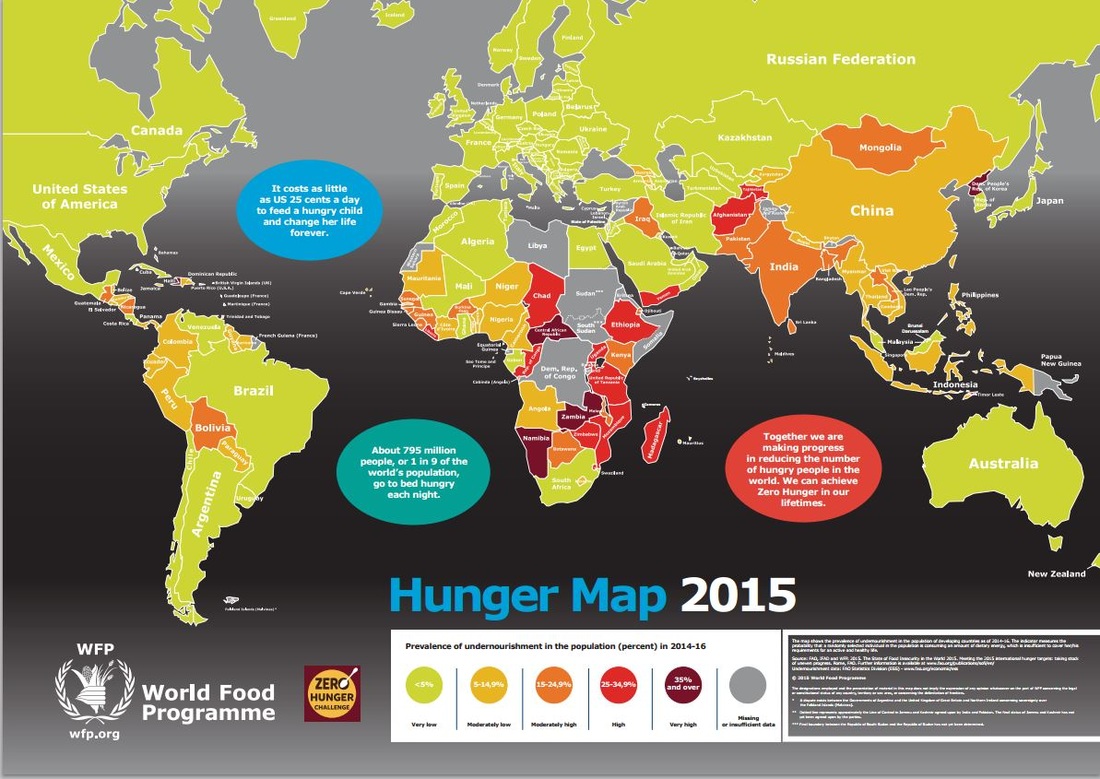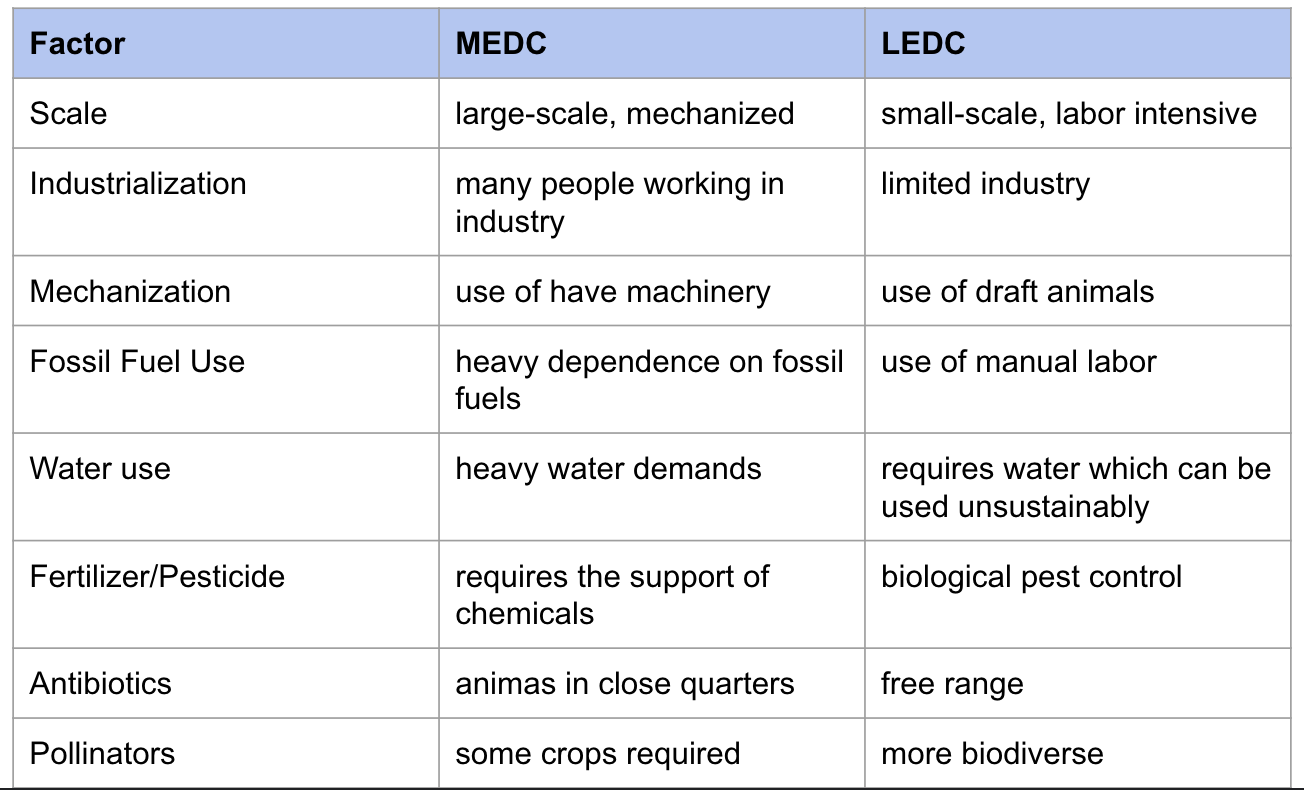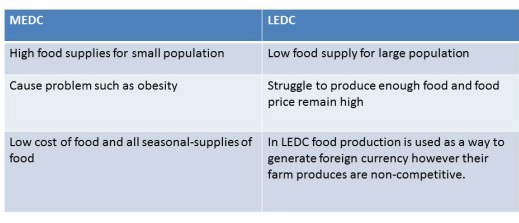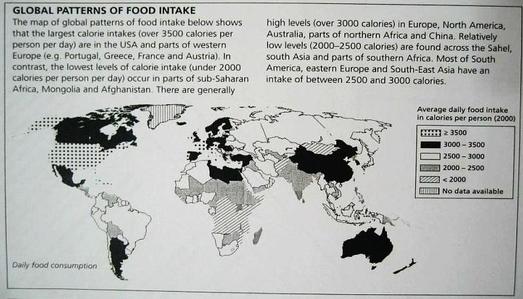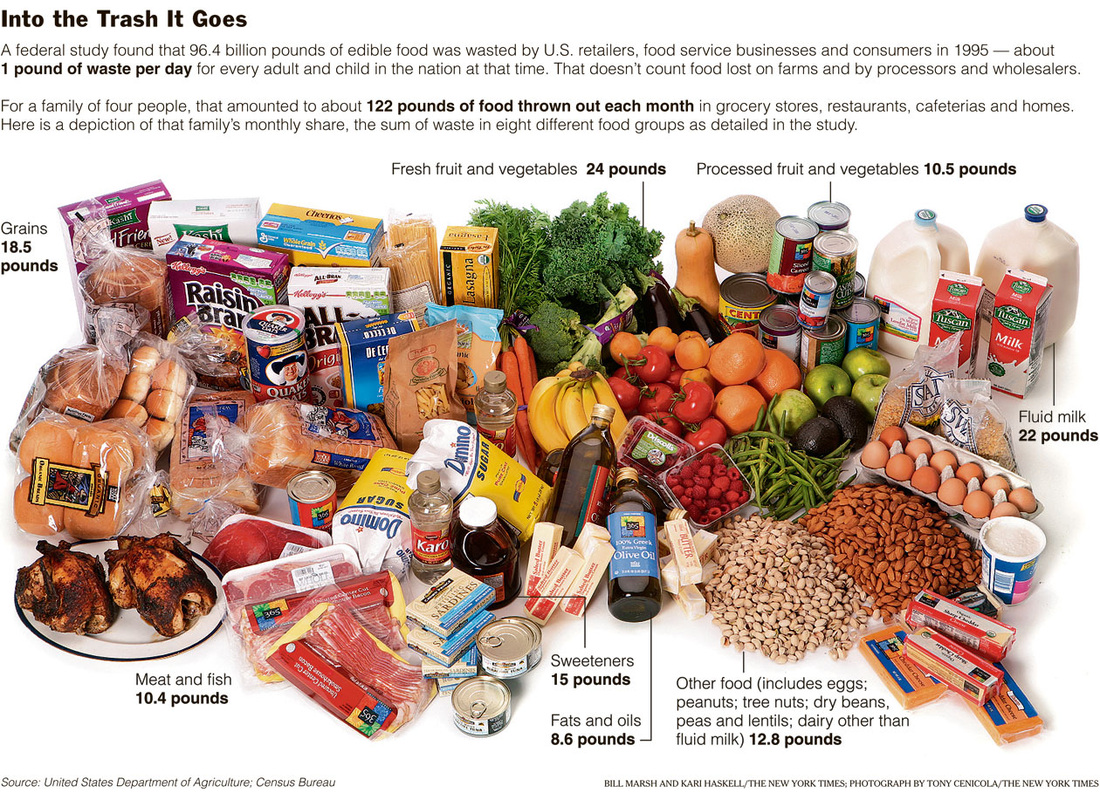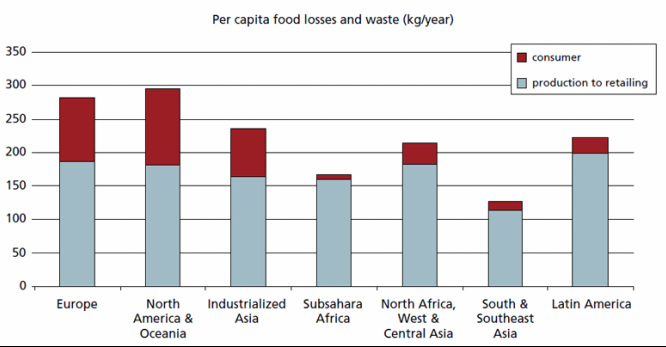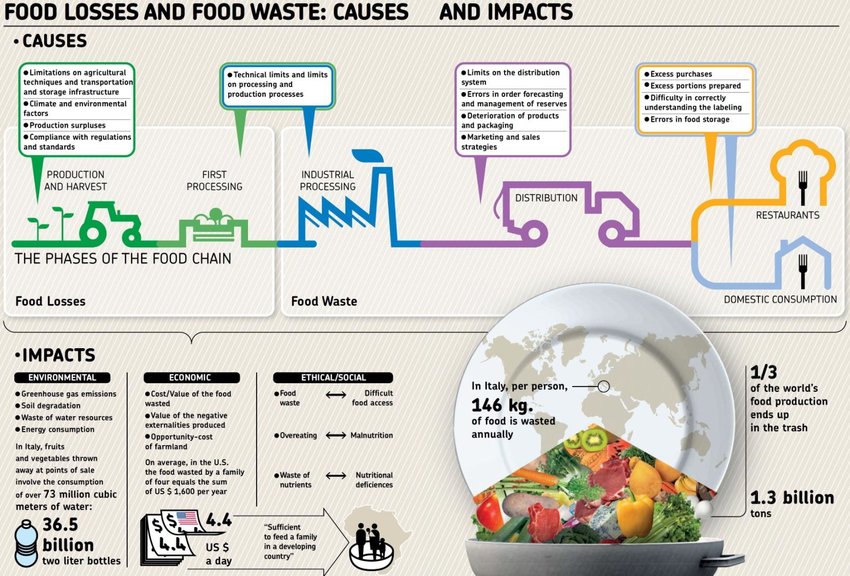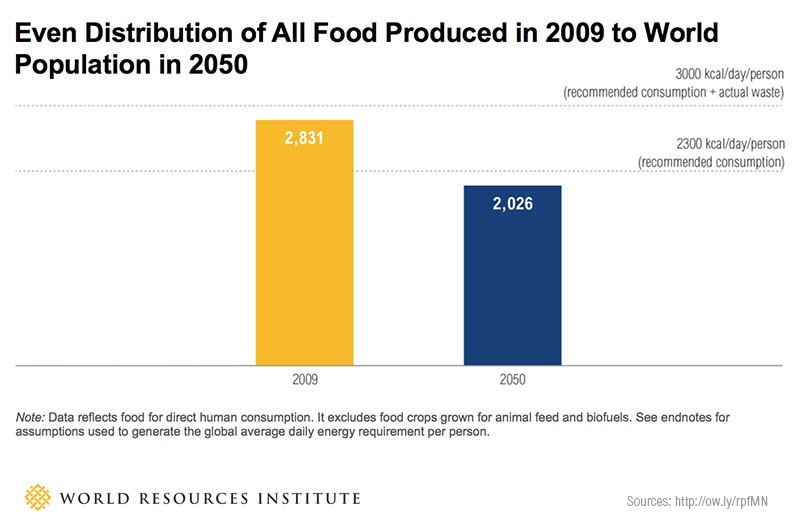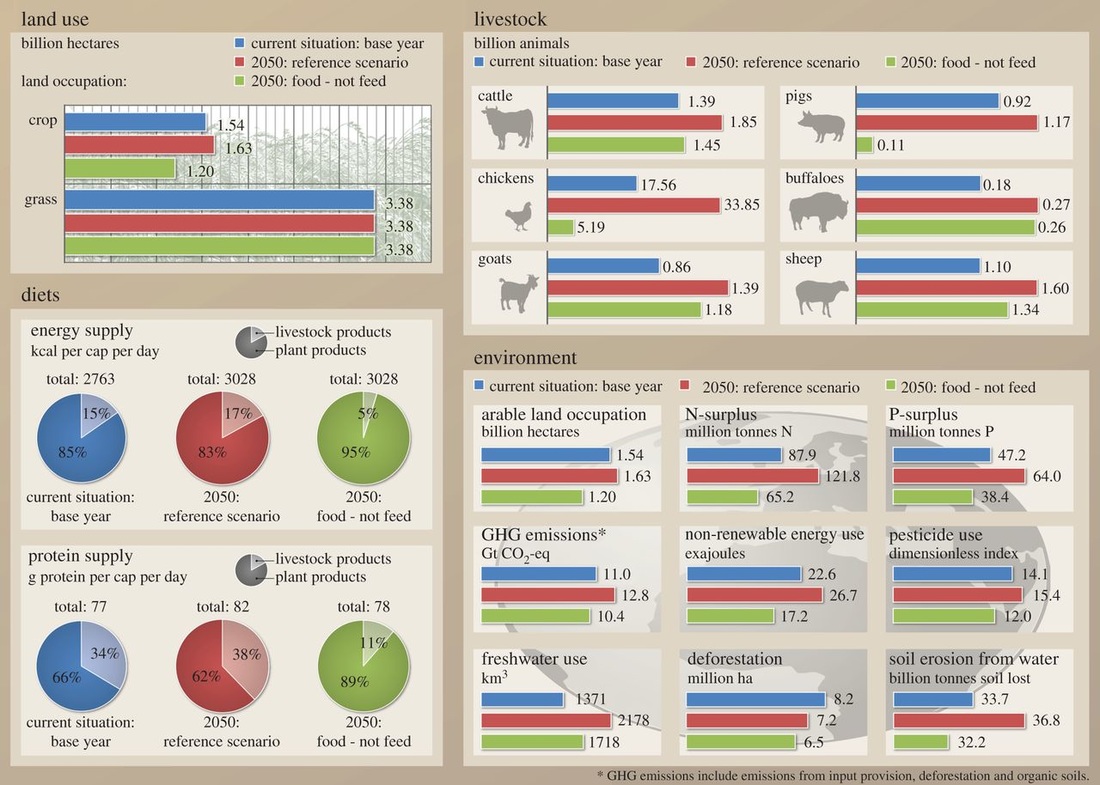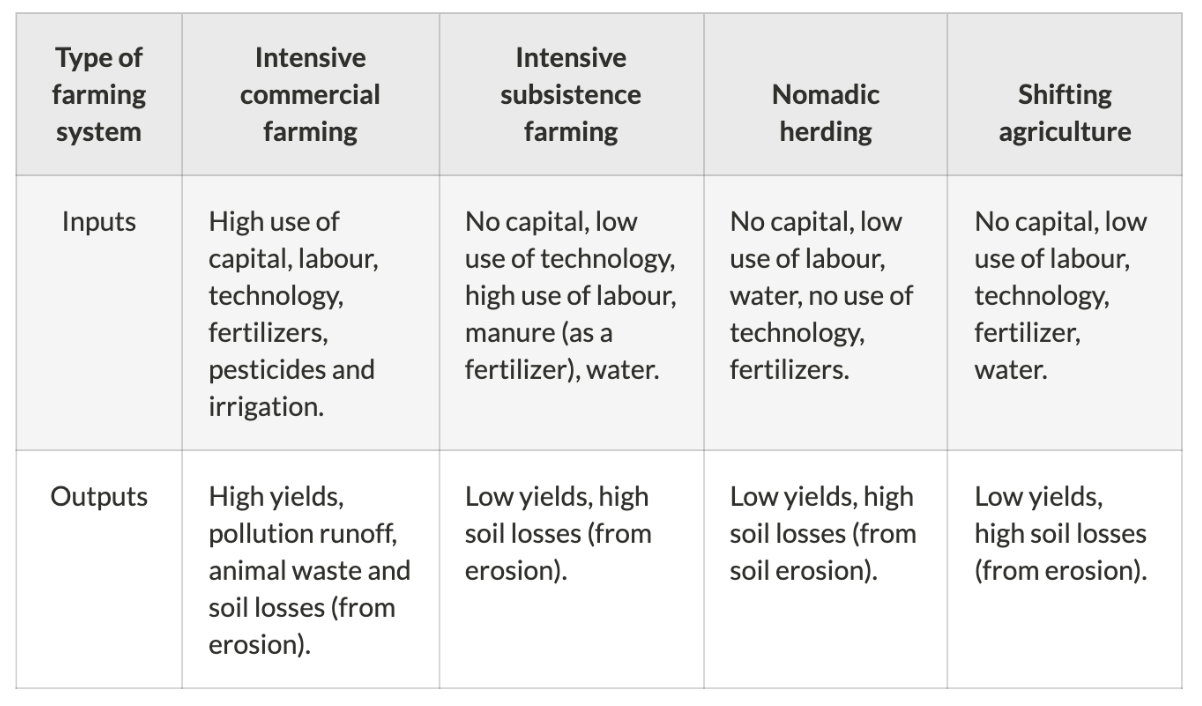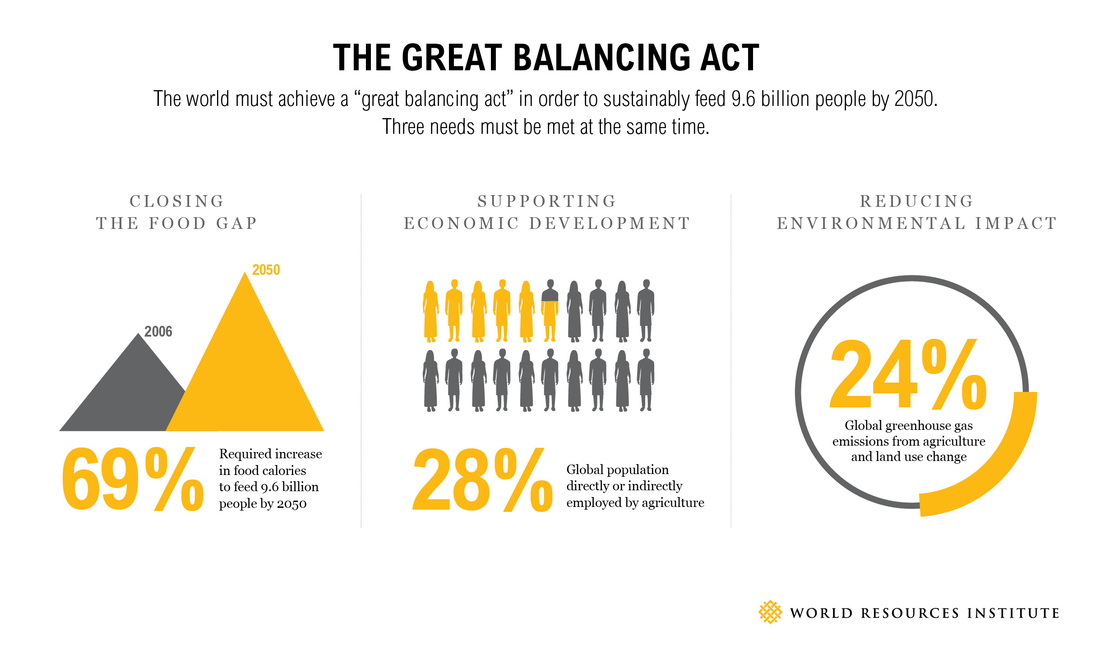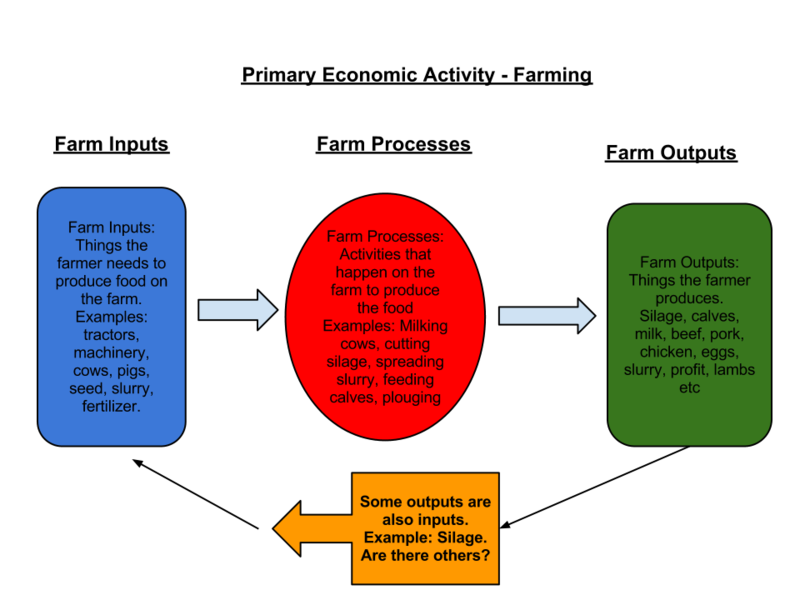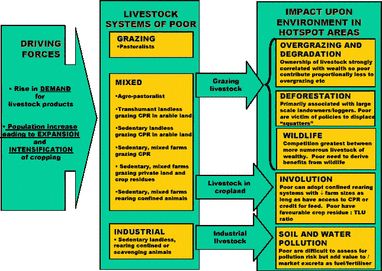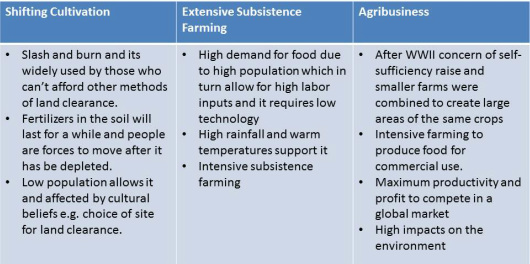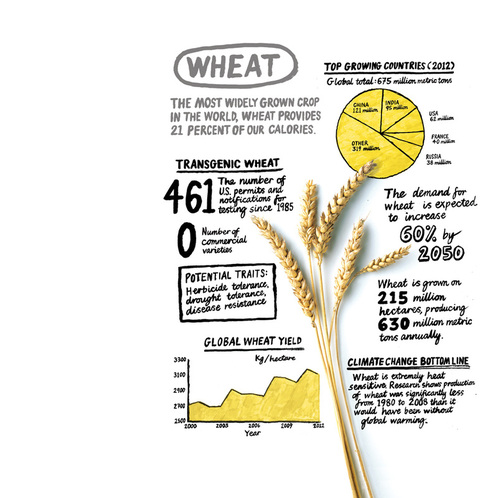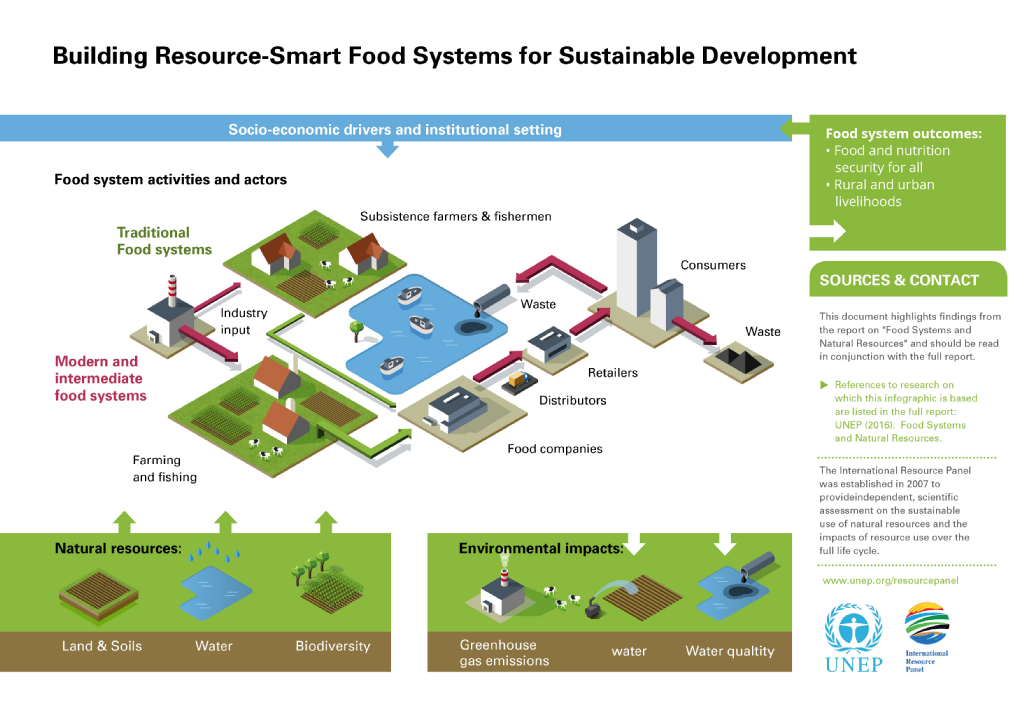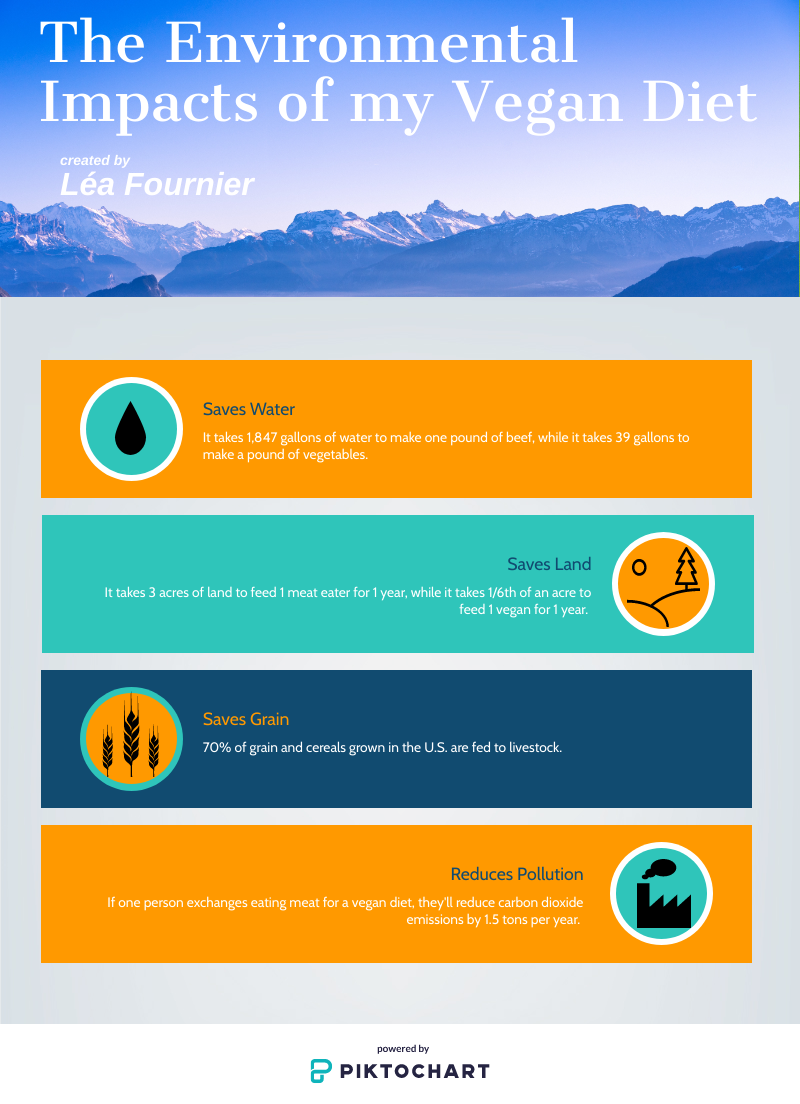topic 5.2: Terrestrial Food Production Systems and Food Choices
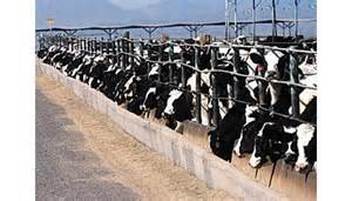 Image from www.learner.org
Image from www.learner.org
The food systems that humans depend on for survival follow the same paths and rules as all ecological food chain. All food chains conform to both the first and second laws of thermodynamics.
World food production differences in productivity and distribution around the world. Socio‑political, economic
and ecological influences can have a significantly effect on the global food supply.
In this unit we will look at the global food supply and how agriculture exerts a set of impacts upon the environment.
This unit is a minimum of 6 hours.
World food production differences in productivity and distribution around the world. Socio‑political, economic
and ecological influences can have a significantly effect on the global food supply.
In this unit we will look at the global food supply and how agriculture exerts a set of impacts upon the environment.
This unit is a minimum of 6 hours.
Significant Ideas:
- The sustainability of terrestrial food production systems is influenced by sociopolitical, economic and ecological factors.
- Consumers have a role to play through their support of different terrestrial food production systems.
- The supply of food is inequitably available and land suitable for food production is unevenly distributed among societies, and this can lead to conflict and concerns.
Big questions:
- Which strengths and weaknesses of the systems approach and of the use of models have been revealed through this topic?
- To what extent have the solutions emerging from this topic been directed at preventing environmental impacts. limiting the extent of the environmental impacts, or restoring systems in which environmental impacts have already occurred?
- What value systems are at play in the causes and approaches to resolving the issues addressed in this topic?
- How are the issues addressed in this topic relevant to sustainability or sustainable development?
- How can systems diagrams be used to show the impact of farming methods on natural systems?
- What are the limitations of such diagrams?
- How can the choice of farming systems prevent environmental impacts, or limit the extent of environmental impacts?
- How do EVSs influence the choice of farming systems?
- What are the issues relating to sustainable terrestrial food production? Is sustainable agriculture possible?
Knowledge & Understanding
5.2.U1 The sustainability of terrestrial food production systems is influenced by factors such as scale; industrialization; mechanization; fossil fuel use; seed, crop and livestock choices; water use; fertilizers; pest control; pollinators; antibiotics; legislation; and levels of commercial versus subsistence food production.
- Define subsistence farming, cash cropping, intensive farming, nomadic, shifting and commercial farming.
- Discuss the environmental impacts of intensive commercial farming.
- Evaluate organic farming methods.
- Describe different subsistence farming systems.
- Compare and contrast the sustainability of subsistence vs commercial farming
- Briefly outline four ranging examples of food production systems.
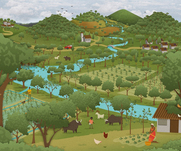
There are many factors that affect food production. The post-war ‘second agricultural revolution’ in developed countries, and the ‘green revolution’ in developing nations in the mid-1960s transformed agricultural practices and raised crop yields dramatically, but the effect is levelling off and will not meet projected demand
At the same time, many other factors are having severe impacts on food production: water stress and desertification is reducing the amount of arable land; many pests are becoming resistant to insecticides, but many of the most effective chemical agents are now banned under environmental regulations; underdeveloped infrastructure means that losses increase further during transport and storage; consumption patterns are changing and developing nations such as India and China have an increased appetite for meat, and climate change is bringing new microbial diseases to food-growing regions along with more extreme and unpredictable weather patterns.
Increases in global populations and changes in diet have put pressure on terrestrial food production systems. Arable land is becoming limited due to increasing human settlements and urbanization. Soils are becoming degraded through intensive farming. Increased agriculture has led to the loss of biodiversity as native habitats have been cleared.
The type of farming chosen and levels of food production will dependent on:
Farms can specialize in particular types of products
At the same time, many other factors are having severe impacts on food production: water stress and desertification is reducing the amount of arable land; many pests are becoming resistant to insecticides, but many of the most effective chemical agents are now banned under environmental regulations; underdeveloped infrastructure means that losses increase further during transport and storage; consumption patterns are changing and developing nations such as India and China have an increased appetite for meat, and climate change is bringing new microbial diseases to food-growing regions along with more extreme and unpredictable weather patterns.
Increases in global populations and changes in diet have put pressure on terrestrial food production systems. Arable land is becoming limited due to increasing human settlements and urbanization. Soils are becoming degraded through intensive farming. Increased agriculture has led to the loss of biodiversity as native habitats have been cleared.
The type of farming chosen and levels of food production will dependent on:
- Environmental conditions e.g. weather (precipitation, sunlight, temperature), topography and soil conditions
- Access to vehicles and technology, such as tractors and animal feeding systems.
- Available financial funds to purchase land, seeds, fertilizers, pesticides, equipment and labor.
- Cultural and environmental value systems
- Government and political initiatives
Farms can specialize in particular types of products
- arable farms will focus on crops such as corn
- pastoral farms focus on rearing animals
- ‘mixed’ farms that produce both
- Subsistence farms (shifting, nomadic) provide food for own use
- Intensive subsistence farming provide food for own use and some for sale profit
- Organic farming – prohibits GMOs and chemical pesticides.
- Cash crops for market only
- Intensive commercial (crop, animal) large scale for profit
5.2.U2 Inequalities exist in food production and distribution around the world
- Explain reasons for differences in food production around the world.
- Identify factors that contribute to hunger around the world.
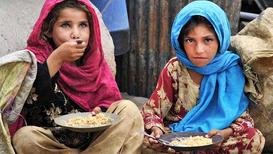
The United Nations Food and Agriculture Organization estimates that nearly 870 million people of the 7.1 billion people in the world, or one in eight, were suffering from chronic undernourishment in 2010-2012. Almost all the hungry people, 852 million, live in developing countries, representing 15 percent of the population of developing counties. There are 16 million people undernourished in developed countries. Chronic under-nourishment, during childhood leads to permanent damage: stunted growth, mental retardation, and social and developmental disorders. Many are also suffering from malnutrition (enough energy but not enough essential nutrients).
In many MEDCs, the cost of food is relatively cheap and people choose food based on preference not nutritional need. Seasonal foods have almost disappeared as foods are readily available all year round. Modern technology and transport systems mean that foreign foods can be bought in almost any market. In LEDCs, many populations struggle to produce enough food to sustain them. Arable land is scarce. There may also be political agendas as well as simple environmental limitations on food production. Crops that are grown are often exported for profit (cash cropping) and not for the local communities. Arable land is in finite supply.
There are large differences in food production in the world but distribution is the problem. Countries like USA, Canada, and Australia produce more food than they need but who should pay for it to be distributed to poorer countries in need such as Bangladesh, Sudan and Ethiopia. The political angle attached to this means that perhaps the receiving country maybe in the others debt, and prone to exploitation. Who decides who gets this food? These are issues that revolve around the topic of food distribution.
The diets of MEDCs and LEDCs, differ as well. MEDCs average calorie intake is about 3314 whereas LEDCs is only about 2666 per day. As we adapt more and more of the net primary productivity on Earth to human needs, use and degrade more land, demand more meat, we must be reaching our limits.
Agriculture in the LEDCs are in contrast and have low levels of technology, lack of capital and high levels of labour."
In many MEDCs, the cost of food is relatively cheap and people choose food based on preference not nutritional need. Seasonal foods have almost disappeared as foods are readily available all year round. Modern technology and transport systems mean that foreign foods can be bought in almost any market. In LEDCs, many populations struggle to produce enough food to sustain them. Arable land is scarce. There may also be political agendas as well as simple environmental limitations on food production. Crops that are grown are often exported for profit (cash cropping) and not for the local communities. Arable land is in finite supply.
There are large differences in food production in the world but distribution is the problem. Countries like USA, Canada, and Australia produce more food than they need but who should pay for it to be distributed to poorer countries in need such as Bangladesh, Sudan and Ethiopia. The political angle attached to this means that perhaps the receiving country maybe in the others debt, and prone to exploitation. Who decides who gets this food? These are issues that revolve around the topic of food distribution.
The diets of MEDCs and LEDCs, differ as well. MEDCs average calorie intake is about 3314 whereas LEDCs is only about 2666 per day. As we adapt more and more of the net primary productivity on Earth to human needs, use and degrade more land, demand more meat, we must be reaching our limits.
Agriculture in the LEDCs are in contrast and have low levels of technology, lack of capital and high levels of labour."
Cause in imbalance food distribution
- Ecological: some climate and soils are better for food production
- Economic: advance technology and money can overcome ecological limitation (transportation of water)
- Socio-political: underinvestment in rural area and rapid area in LEDC; poor human health weaken available labor force
|
Ecological
|
Economic
|
Socio political
|
5.2.U3 Food waste is prevalent in both LEDCs and more economically developed countries (MEDCs), but for different reasons.
[Food waste is an issue arising in MEDCs, where regulatory standards may be set according to commercial preferences so that consumable food is discarded. It can also be an issue in LEDCs, where the necessary refrigeration and transport infrastructure is insufficient to avoid food spoilage.]
[Food waste is an issue arising in MEDCs, where regulatory standards may be set according to commercial preferences so that consumable food is discarded. It can also be an issue in LEDCs, where the necessary refrigeration and transport infrastructure is insufficient to avoid food spoilage.]
- Distinguish between the reasons for food waste in less economically developed countries and more economically developed countries.
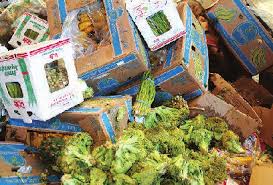
As countries develop and consumption increases so does the amount of waste per capita, and pollution becomes a greater problem. There are global, national and local strategies in place to reduce levels of waste and minimize impact on the environment.
Global waste production
The amount and type of waste produced varies between countries.
MEDCs have higher levels of consumption, so many produce more waste than LEDCs. Ireland and the USA produce over 700 kg of waste per person per year. In LEDCs the figure is around 150 kg per person per year. This difference is due to different levels of consumption; it is also more common to reuse items in LEDCs.
As a country becomes more wealthy, the demand for consumer items increases. This means that items are replaced more frequently - leading to larger quantities of waste. For example, mobile phones and computers that still work may be discarded for a newer version.
In LEDCs waste production is lower because:
The key food waste issues are:
Global waste production
The amount and type of waste produced varies between countries.
MEDCs have higher levels of consumption, so many produce more waste than LEDCs. Ireland and the USA produce over 700 kg of waste per person per year. In LEDCs the figure is around 150 kg per person per year. This difference is due to different levels of consumption; it is also more common to reuse items in LEDCs.
As a country becomes more wealthy, the demand for consumer items increases. This means that items are replaced more frequently - leading to larger quantities of waste. For example, mobile phones and computers that still work may be discarded for a newer version.
In LEDCs waste production is lower because:
- Less is bought because people are typically on lower incomes
- Less packaging is used on products
- Disposable items (eg razors, plastic plates and diapers) are used less
- Lower literacy levels means there is less production of written material
The key food waste issues are:
|
|
5.2.U4 Socio-economic, cultural, ecological, political and economic factors can be seen to influence societies in their choices of food production systems
- Explain the role of consumer choice on farming methods.
- Define food miles
- Evaluate use of farmers markets.
- Discuss factors that influence a society’s choice of food production systems.
 image from www.eufic.org
image from www.eufic.org
Social influences on food intake refer to the impact that one or more persons has on the eating behavior of others, either direct or indirect, either conscious or subconscious. The relationship between low socio-economic status and poor health is complicated and is influenced by gender, age, culture, environment, social and community networks, individual lifestyle factors and health behaviors.
There are clear differences in social classes with regard to food and nutrient intakes. Low-income groups in particular, have a greater tendency to consume unbalanced diets and have low intakes of fruit and vegetables.
Education level and income determine food choices and behaviors that can ultimately lead to diet-related diseases. The origins of many of the problems faced by people on low incomes emphasizes the need for a multidisciplinary approach to targeting social needs and improving health inequalities.
There are clear differences in social classes with regard to food and nutrient intakes. Low-income groups in particular, have a greater tendency to consume unbalanced diets and have low intakes of fruit and vegetables.
Education level and income determine food choices and behaviors that can ultimately lead to diet-related diseases. The origins of many of the problems faced by people on low incomes emphasizes the need for a multidisciplinary approach to targeting social needs and improving health inequalities.
5.2.U5 As the human population grows, along with urbanization and degradation of soil resources, the availability of land for food production per capita decreases.
- Explain how human population growth will affect food production systems and sustainability.
As the world population continues to grow in almost all continents, great pressure is being placed on arable land, water, energy, and biological resources to provide an adequate supply of food while maintaining the integrity of our ecosystem. As the world population grows, the food problem will become increasingly severe. The most venerable will be population in developing countries. The per capita availability of world grains, which make up 80 per cent of the world’s food, has been declining for the past 25 years. Certainly with a quarter million people being added to the world population each day, the need for grains and all other food will reach unprecedented levels.
5.2.U6 The yield of food per unit area from lower trophic levels is greater in quantity, lower in cost and may require fewer resources
- Compare and contrast aquatic and terrestrial food production in terms of efficiency.
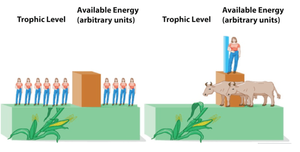 image from www.sciencemusicvideos.com
image from www.sciencemusicvideos.com
Most food chains do not have a fourth or fifth trophic level, because energy is not sufficient to sustain fourth or fifth trophic level. As you progress a trophic level only a percentage is passed on to the next organism (approximately 10%- as a result of the energy required to maintain homeostasis), so it would not be efficient to eat an animal that would give you a small biomass.
More people on Earth could be supported for a given area of land farmed if individuals eat lower on the food chain. Eating primary producers instead of eating herbivores could support the same number of people as at present, but with less land degradation because we wouldn't need to have so much land in production. These consequences of a change in our diets result from the basic thermodynamic principles outlined above.
The UN's Food and Agriculture Organization (FAO) estimates that ~ 30% of the ice-free land surface area of Earth is directly or indirectly involved in livestock production!
Eating lower on the food chain, one or more of the following benefits would be likely:
More people on Earth could be supported for a given area of land farmed if individuals eat lower on the food chain. Eating primary producers instead of eating herbivores could support the same number of people as at present, but with less land degradation because we wouldn't need to have so much land in production. These consequences of a change in our diets result from the basic thermodynamic principles outlined above.
The UN's Food and Agriculture Organization (FAO) estimates that ~ 30% of the ice-free land surface area of Earth is directly or indirectly involved in livestock production!
Eating lower on the food chain, one or more of the following benefits would be likely:
- Not as much land and other resources raising grain to feed to animals.
- Overgrazing on public and private range lands could decrease.
- Would not have to farm or graze marginal lands as intensively
- More people in the world could receive an adequate diet
- Less fossil fuel energy (and associated emissions of CO2) would be required to produce our food.
5.2.U7 Cultural choices may influence societies to harvest food from higher trophic levels.
- Discuss factors that influence a society’s choice of food production systems.
 image .sustainablecitiesinstitute.org
image .sustainablecitiesinstitute.org
Most food is harvested from low trophic levels (producers and herbivores). Systems that produce crops are more energy efficient then those which produce livestock. This is because energy is greater in proportion in the low trophic levels. Even though it is efficient to use arable systems, many cultures still use livestock as part of their farming system. Taste and cultural demand play a major role in this and the animals also provide a source protein which is essential for the human diet. Animals are also used as working animals in some cultures.
5.2.U8 Increased sustainability may be achieved through: altering human activity to reduce meat consumption and increase consumption of organically grown and locally produced terrestrial food products, improving the accuracy of food labels to assist consumers in making informed food choices, monitoring and control of the standards and practices of multinational and national food corporations by governmental and intergovernmental bodies, planting of buffer zones around land suitable for food production to absorb nutrient runoff.
- Outline the reasons for increase in demand for meat.
- Justify whether the increase in demand for meat is sustainable.
- Describe factors that influence sustainability of farming systems
- Discuss sustainable farming strategies.
Farming must feed more people more sustainable. Advances in agricultural science and technology have contributed to remarkable increases in food production since the mid-twentieth century. Global agriculture has grown 2.5–3 times over the last 50 years. This has let food production keep pace with human population growth so that, overall, there are enough calories produced per capita. However, progress toward reducing hunger is variable across the world
5.2.U9 Increased sustainability may be achieved through:
- – altering human activity to reduce meat consumption and increase consumption of organically grown and locally produced terrestrial food products
- – improving the accuracy of food labels to assist consumers in making informed food choices
- – monitoring and control of the standards and practices of multinational and national food corporations by governmental and intergovernmental bodies
- – planting of buffer zones around land suitable for food production to absorb nutrient runoff.
Organic farming
- provides an ecocentric approach
- balance that conserves soil fertility, reduces pest outbreaks and takes a preventative rather than reactive approach
- creates local markets
- reduces food miles
- farming involves growing multiple crops rather than focusing only on one.
- Using alternative approaches to reduce pest such as biological control i.e. the use of natural predators.
- Only applying pesticides when and where required
- Using biodegradable pesticides
- Using pesticides that are target specific
- Improving food labels would help consumer to make increasingly informed food choices
- Buying locally would minimize food miles
- Control drugs
- Control pesticides
- Regulation of environmental conditions required for rearing and transporting livestock, such as minimum space requirement per animal within intensive farming systems.
- Land surrounding fields on which carefully combined strips of native vegetation
- Support biodiversity
- Minimize the risk of leaching of unwanted substances from arable land, increasing biodiversity by attracting pollinators and ‘natural enemies’, acting as field roads for farming vehicles to avoid soil compaction
- Reduce wind erosion
Application & Skills
5.2.A1 Analyse tables and graphs that illustrate the differences in inputs and outputs associated with food production systems.
Terrestrial farming systems can be divided into several types
Commercial and subsistence farming can be intensive or extensive
Organic farming prohibits the use of genetically modified organisms (GMOs), chemical fertilizers and restricts the use of chemical pesticides.
Nomadic herding involves moving with animals such as cattle and goats, in search of suitable grazing areas.
Shifting agriculture is a method of cultivation involves clearing land, typically tropical forest by cutting and burning (often referred to as slash and burn).
- Commercial farming in which farming is for profit. This usually involves one crop
- Subsistence farming in which food is produced only to feed the farmer and family. No sale for profit
Commercial and subsistence farming can be intensive or extensive
- Intensive farms generally take up a small area of land but aim to have very high outputs per unit area of land
- Extensive farms are usually large in comparison to the money and labor put into them
Organic farming prohibits the use of genetically modified organisms (GMOs), chemical fertilizers and restricts the use of chemical pesticides.
Nomadic herding involves moving with animals such as cattle and goats, in search of suitable grazing areas.
Shifting agriculture is a method of cultivation involves clearing land, typically tropical forest by cutting and burning (often referred to as slash and burn).
5.2.A2 Compare and contrast the inputs, outputs and system characteristics for two given food production systems.
[Possible examples for contrasting terrestrial food production systems include North American cereal farming and subsistence farming in Southeast Asia, or intensive beef production in South America and the Maasai tribal use of livestock. These examples are not meant to be prescriptive and appropriate local examples are also encouraged.]
[Ensure you are able to compare and contrast different farming systems. This should include inputs, outputs, techniques used and environmental impacts.]
[Possible examples for contrasting terrestrial food production systems include North American cereal farming and subsistence farming in Southeast Asia, or intensive beef production in South America and the Maasai tribal use of livestock. These examples are not meant to be prescriptive and appropriate local examples are also encouraged.]
[Ensure you are able to compare and contrast different farming systems. This should include inputs, outputs, techniques used and environmental impacts.]
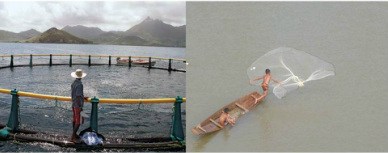
The systems selected should be both terrestrial or both aquatic. In addition, the inputs and outputs of the two systems should differ qualitatively and quantitatively (not all systems will be different in all aspects).
The pair of examples could be North American cereal farming and subsistence farming in some parts of South‑East Asia, intensive beef production in the developed world and the Maasai tribal use of livestock, or commercial salmon farming in Norway/Scotland and rice‑fish farming in Thailand. Other local or global examples are equally valid.
The pair of examples could be North American cereal farming and subsistence farming in some parts of South‑East Asia, intensive beef production in the developed world and the Maasai tribal use of livestock, or commercial salmon farming in Norway/Scotland and rice‑fish farming in Thailand. Other local or global examples are equally valid.
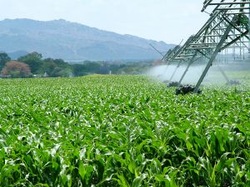
Factors to be considered should include:
- inputs - fertilizers (artificial or organic); water (irrigation or rainfall); pest control (pesticides or natural predators); labour (mechanized and fossil-fuel dependent or physical labour); seed (genetically modified organisms—GMOs—or conventional); breeding stock (domestic or wild); livestock growth promoters (antibiotics or hormones vs organic or none)
- outputs - outputs, such as food quality, food quantity, pollutants (air, soil, water), consumer health, soil quality (erosion, degradation, fertility); common pollutants released from food production systems include fertilizers, pesticides, fungicides, antibiotics, hormones and gases from the use of fossil fuels; transportation, processing and packaging of food may also lead to further pollution from fossil fuels system characteristics—selective breeding, genetically engineered organisms, monoculture versus polyculture, sustainability,
- system characteristics - such as diversity (monoculture versus polyculture); sustainability; indigenous versus introduced crop species socio‑cultural—the Maasai cattle equals wealth and quantity is more important than quality;
- environmental impact—pollution (air, soil, water); habitat loss; biodiversity loss; soil erosion or degradation; desertification; disease epidemics from high-density livestock farming
- socio-economic factors - arming for profit or subsistence, for export or local consumption, for quantity or quality; traditional or commercial farming.
- Scale
- Industrialization
- Mechanization
- Fossil fuel use
- Seed/crop/livestock choices
- Water use
- Fertilizer use and pest control
- Use of pollinators
- Antibiotic use
- Impacts of legislation on operations

Example of compare and contrast from http://yesitsyomoma.wordpress.com
Terrestrial Systems:
Intensive Charolais beef production in France:
In Western Europe the Charolais beef is one of the beef brands chosen. Through selective breeding and genetic engineering bloodlines that puts weight on exist but has a low fat cover. Charolais lives under controlled conditions, they are fed with high proteins and treated with antibiotics to make sure they are healthy. Lots of energy is used in transporting and processing the finished meat.
Cattle raised outdoors however grown on single monoculture ( cultivation of a single crop on a farm or in a region or country) grass land in large fields with a high stock rate. To keep the productivity of these fields going, large amounts of fertilizer are used.
This intensified farming e the 1940′s with the aim of producing cheaper meat has led to habitat loss as they have been removed to make bigger fields and cases of Eutrophication have increased as excess use of fertilizers and large amounts of slurry produced in the system enter water courses. Fear of causing antibiotic resistance in human bacteria through bioaccumulation.
Inputs:
- high use of energy for food distribution
- high use of capital
- high use of technology
- high use of labor
- high use of food supplements
- selective breeding and genetic engineering (system characteristics)
- indoor rearing
- fertilizers to maximize grass production
- high use of antibiotics and hormones
- cheap meat (socio-cultural)
- high habitat destruction to make bigger fields (environmental impact)
- high antibiotic resistance
- eutrophication
- high yields
- high pollution runoff (environmental impact)
- high animal waste (environmental impact)
- high soil losses (from erosion).
Nomadic cattle grazing of the Himba:
The Charolais beef production can be contrasted with the Nomadic cattle grazing of the Himba. The Himba people are from North West Namibia, they survive by being Nomadic hunters/grazers. They also have a tight bond with the cattle they graze. During the dry seasons the Himba move their cattle from area to area until the grass is used up until the raining season, they go to better pastures. Cattle to the Himba are very important as they provide; meat, milk, skins and even dung for fires. Prestige between the Himba is seen by how many cattle they have, not the size of the cattle. The cattle during the dry season may start competing with herbivores. This has increased especially with global warming drought periods. This can lead to soil erosion as extra grazing pressure removes the grasses that hold the top soil together.
Input:
- nomadic grazing moving from place to place so land has a chance to recover
- cattle survive on low grade natural forage with no supplements
- during drought cattle die as grass disappears adding patches of nutrients to the soil (environmental impact)
- no capital
- low use of labor
- low use of water
- no use of technology
- no use of fertilizers.
- Himba cattle provide meat, milk and fuel (dung)
- owning cattle gives status in community (socio-cultural)
- during drought times Himba cattle compete with wild grazers for food this can lead to high soil erosion as well as food shortage (environmental impact)
- low yields,
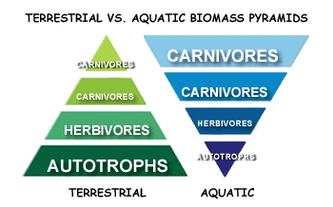 image from www.arctic.uoguelph.ca
image from www.arctic.uoguelph.ca
Compare and contrast these in terms of their trophic levels and efficiency of energy conversion. There is no need to consider individual production systems in detail. In terrestrial systems, most food is harvested from relatively low trophic levels (producers and herbivores).
In aquatic systems, perhaps largely due to human tastes, most food is harvested from higher trophic levels where the total storages are much smaller. Although energy conversions along the food chain may be more efficient in aquatic systems, the initial fixing of available solar energy by primary producers tends to be less efficient due to the absorption and reflection of light by water.
The Second Law of Thermodynamics states that energy goes from a concentrated form (like the sun) to a dispersed form (like heat), the availability of energy to do work therefore diminishes on the system becomes increasingly disorder. It explains how energy transformations in living systems can lead to loss of energy from the system. The order in living systems is only maintained by constant input of new energy from the sun.
We get to see from the second law of thermodynamics that energy conversion through food chains is inefficient and that energy is lost by respiration and waste production at each level within the food web.
Energy in sunlight -> producer (90% energy lost) -> primary consumer (9% energy lost) -> secondary consumer (0.9% energy lost)
100% -> 10% -> 1% -> 0.1%
In aquatic systems, perhaps largely due to human tastes, most food is harvested from higher trophic levels where the total storages are much smaller. Although energy conversions along the food chain may be more efficient in aquatic systems, the initial fixing of available solar energy by primary producers tends to be less efficient due to the absorption and reflection of light by water.
The Second Law of Thermodynamics states that energy goes from a concentrated form (like the sun) to a dispersed form (like heat), the availability of energy to do work therefore diminishes on the system becomes increasingly disorder. It explains how energy transformations in living systems can lead to loss of energy from the system. The order in living systems is only maintained by constant input of new energy from the sun.
We get to see from the second law of thermodynamics that energy conversion through food chains is inefficient and that energy is lost by respiration and waste production at each level within the food web.
Energy in sunlight -> producer (90% energy lost) -> primary consumer (9% energy lost) -> secondary consumer (0.9% energy lost)
100% -> 10% -> 1% -> 0.1%
Terrestrial farming systems are divided into two types:
Both commercial and subsistence can be intensive or extensive farms
- Commercial farming: for profit, often monoculture
- Subsistence farmer: produces only enough to feed their family with no sell for profit
Both commercial and subsistence can be intensive or extensive farms
- Intensive farms: take a small area of land for a high input
- Extensive farms: large in comparison to the money and labour put into it
5.2.A3 Evaluate the relative environmental impacts of two given food production systems.
Food production and the supply chain can have wide-ranging positive and negative impacts on the environment. Negative impacts include escalating water and land use, soil erosion and degradation through loss of fertility or desertification, loss of biodiversity, and intensive use of energy (for production, notably for fertiliser manufacture, and for supply, especially in transport and refrigeration) with associated greenhouse gas emissions
Factory farming reduces the amount of land needed for meat production, however, these farms are a serious air and water pollutant. The waste of these animals ends up in the nature and poses a constant risk of drinking water contamination and seriously affects the air quality of the nearby areas. One solution for the problem with animal waste lays in its use for production of biofuel which can then be used for production of electricity but this practice is the exception rather than the rule.
Mass meat production has shown main contributors to carbon dioxide emissions which in turn are the main cause of the climate change. The meat industry is estimated to be responsible for about 9 percent of total carbon dioxide emissions which are a result of emissions of various gases from the farms as well as from the microbial activities after application of animal waste as fertilizers.
Animal husbandry poses a serious threat to the local ecosystems and biodiversity due to the use of the land for grazing and animal feed production. As much as one quarter of the Earth’s surface is used for grazing and about one third of arable land is used to produce animal feed. As a result, the wildlife species struggle with lack of habitat, while some are even threatened with extinction.
Consider the environmental impact of food production systems on:
Factory farming reduces the amount of land needed for meat production, however, these farms are a serious air and water pollutant. The waste of these animals ends up in the nature and poses a constant risk of drinking water contamination and seriously affects the air quality of the nearby areas. One solution for the problem with animal waste lays in its use for production of biofuel which can then be used for production of electricity but this practice is the exception rather than the rule.
Mass meat production has shown main contributors to carbon dioxide emissions which in turn are the main cause of the climate change. The meat industry is estimated to be responsible for about 9 percent of total carbon dioxide emissions which are a result of emissions of various gases from the farms as well as from the microbial activities after application of animal waste as fertilizers.
Animal husbandry poses a serious threat to the local ecosystems and biodiversity due to the use of the land for grazing and animal feed production. As much as one quarter of the Earth’s surface is used for grazing and about one third of arable land is used to produce animal feed. As a result, the wildlife species struggle with lack of habitat, while some are even threatened with extinction.
Consider the environmental impact of food production systems on:
- soil degradation from erosion
- desertification
- eutrophication from agricultural run-off
- pollution from insecticides, pesticides and fertilizers
- salinization from over-irrigation
- lowered water tables and over-abstraction of ground water
- loss of valuable habitats
- disease epidemics from high-density livestock farming and monoculture.
5.2.A4 Discuss the links that exist between sociocultural systems and food production systems.
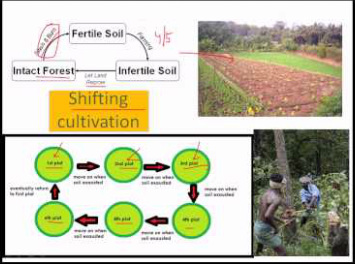
This could be illustrated through the use of examples, such as:
There are many factors that come into consideration as to the method and level of sustainability of food production methods. Population density/size, culture, soil fertility, and method of agriculture are some of these factors.
Shifting cultivation is an agricultural system in which plots of land are cultivated temporarily, then abandoned and allowed to revert to their natural vegetation while the cultivator moves on to another plot. The period of cultivation is usually terminated when the soil shows signs of exhaustion or, more commonly, when the field is overrun by weeds. The length of time that a field is cultivated is usually shorter than the period over which the land is allowed to regenerate by lying fallow.
Of these cultivators, many use a practice of slash-and-burn as one element of their farming cycle. Others employ land clearing without any burning, and some cultivators are purely migratory and do not use any cyclical method on a given plot. Sometimes no slashing at all is needed where regrowth is purely of grasses, an outcome not uncommon when soils are near exhaustion and need to lie fallow.
One land-clearing system of shifting agriculture is the slash-and-burn method, which leaves only stumps and large trees in the field after the standing vegetation has been cut down and burned, its ashes enriching the soil. Cultivation of the earth after clearing is usually accomplished by hoe or digging stick and not by plough.
- the way in which the low population densities and belief systems of shifting cultivators links with the ecosystem of “slash and burn” agriculture;
- the relationship between high population densities, culture, soil fertility and the wetrice ecosystem of South‑East Asia;
- the link between the political economy of modern urban society, corporate capitalism and agro-ecosystems.
There are many factors that come into consideration as to the method and level of sustainability of food production methods. Population density/size, culture, soil fertility, and method of agriculture are some of these factors.
Shifting cultivation is an agricultural system in which plots of land are cultivated temporarily, then abandoned and allowed to revert to their natural vegetation while the cultivator moves on to another plot. The period of cultivation is usually terminated when the soil shows signs of exhaustion or, more commonly, when the field is overrun by weeds. The length of time that a field is cultivated is usually shorter than the period over which the land is allowed to regenerate by lying fallow.
Of these cultivators, many use a practice of slash-and-burn as one element of their farming cycle. Others employ land clearing without any burning, and some cultivators are purely migratory and do not use any cyclical method on a given plot. Sometimes no slashing at all is needed where regrowth is purely of grasses, an outcome not uncommon when soils are near exhaustion and need to lie fallow.
One land-clearing system of shifting agriculture is the slash-and-burn method, which leaves only stumps and large trees in the field after the standing vegetation has been cut down and burned, its ashes enriching the soil. Cultivation of the earth after clearing is usually accomplished by hoe or digging stick and not by plough.
5.2.A5 Evaluate strategies to increase sustainability in terrestrial food production systems.
[Ensure you are able to evaluate strategies used to increase sustainability of food production systems]
[Ensure you are able to evaluate strategies used to increase sustainability of food production systems]
To achieve sustainable food production, many different factors need to be considered. These include:
- Political commitment to sustainable development with the will to make changes, such as new legislative and economic support for sustainable farming systems.
- Understanding of the ecology of farming systems and how they are interconnected to the wider environment. This can be used to inform policies and guidelines that support sustainable farming.
- Change in social and individual behavior.
- Local produce and use of farmers markets
- Growing indigenous crops
- Food Labels
- Monitoring multi-nationals
- Buffer zones (nutrient run-off)
- Use of polyculture instead of monoculture farming involves growing multiple crops rather than focusing only on one.
- Reduction of meat production. The ecological footprint of meat production is significantly greater than for crop production:
Key Terms
|
food production
herbivores nitrates mixed crops herbicides pastoral arable crop rotation undernourishment outputs |
food distribution
socio-cultural GMO fertilizer cash crop mixed fossil fuel harvest trophic level vegetarian |
terrestrial
environmental impact shifting cultivation antibiotics organic extensive domesticate seed crop hunger intensive |
aquatic
slash and burn subsistence growth hormones agribusiness intensive pollinator livestock malnourishment inputs |
producers
biodiversity monoculture pesticides buffer zone urbanisation aquatic desertification salinization soil erosion |
Classroom Materials
Research where your food comes from, both the place and company www.seedmap.org
Community Supported Agriculture (CSA) membership program and/or a Food Co-op www.localharvest.org
Policies that integrate food and urban ag into city planning and zoning www.fao.org/fcit/policy-planning-institutions/en/
Food justice publications www.civileats.com
Equitable Food Oriented Development www.efod.org
What The World Eats
Comparing and Contrasting Farming Systems
Article: U.N. Urges Eating Insects; 8 Popular Bugs to Try
BBC: Could Insects be the Wonder Food of the Future?
Where does our food come from. Interesting interactive map.
Edible GMOs
Case Studies
Research where your food comes from, both the place and company www.seedmap.org
Community Supported Agriculture (CSA) membership program and/or a Food Co-op www.localharvest.org
Policies that integrate food and urban ag into city planning and zoning www.fao.org/fcit/policy-planning-institutions/en/
Food justice publications www.civileats.com
Equitable Food Oriented Development www.efod.org
What The World Eats
Comparing and Contrasting Farming Systems
Article: U.N. Urges Eating Insects; 8 Popular Bugs to Try
BBC: Could Insects be the Wonder Food of the Future?
Where does our food come from. Interesting interactive map.
Edible GMOs
Case Studies
- Two detailed case studies of contrasting food production systems comparing the inputs, outputs, system characteristics, environmental impacts, and socio-cultural systems (eg. industrial beef farming vs. traditional Maasai livestock)
Student Work
Listen to the Following Podcasts
BBC The Inquiry - How Can We Feed 11 Billion People Podcast
Listen to the Podcast and complete the Podcast Review Assignment
Listen to the Podcast and complete the Podcast Review Assignment
The U.S. Has Nearly 1.9 Billion Acres of Land. Here's How It Is Used
Powerpoint and Notes Adapted from Brad Kremer and Masfar
Your browser does not support viewing this document. Click here to download the document.
Your browser does not support viewing this document. Click here to download the document.
Correct use of terminology is a key skill in ESS. It is essential to use key terms correctly when communicating your understanding, particularly in assessments. Use the quizlet flashcards or other tools such as learn, scatter, space race, speller and test to help you master the vocabulary.
Useful Links
Plant Based Diets - WWF
Third World Farmer
Plant something at home and/or join a local community garden www.communitygarden.org
World Food Program
Interactive Map: The State of Food Insecurity in the World 2015
Video: Zero Hunger Challenge
National Geographic: Feeding the World
Food Resources - BBC Bitesize
Food Production and Energy Usage, Efficiency - the Energy Collection
Botany of Desire: The Potato - PBS
History of Certain Plants - PBS
Yields and Land Use in Agriculture
biodiversity International
FAO
Global Crop Diversity
Heifer International
Heifer International Alton Brown Ad
100 Mile Diet
Shifting Cultivation - Dig Planet
Free Rice: Earn Rice for UNICEF
Industrial Agriculture, Agroecology and Climate Change
Reforming Farming to Fight Climate Change
In The News
We need to redefine our relationship with food: How will we feed a hotter, smarter and more crowded world? - World Economic Forum, July 2022
Eight ways to halt a global food crisis - Conservation, July 2019
Drought in Eritrea: Hunger Despite Government Denials - BBC News Africa 4 September 2011
Trees ‘Boost African Crop Yields and Food Security’ - BBC Science and Environment News 16 October 2011
Can an African ‘Green Revolution’ help feed the world? - MSNBC Environment News 2 May 2012
Agroforestry in the Sahel as a model of sustainable agriculture - Scientific American 28 January 2011
Indigenous People Have Much of the Knowledge Needed to Adapt to Climate Change - Trust.org 24 April 2012
Dow and Monsanto Team Up - Earth First February 26th, 2012
Phosphorus Footprint of Your Meat - NPR February 17, 2013
Bananas Impact Ecosystems - NPR September 24, 2013
The Future of Food - National Geographic
Eating Insects Will Help Feed Hungry World, UN Says - LiveScience Contributor 27 Jun 2013
Forests Are Key to Global Food Security - BBC News 6 May 2015
International-mindedness:
- Food choices can be influenced by culture, religion or regional food production differences.
Theory of knowledge:
- Consumer behaviour plays an important role in food production systems—are there general laws that can describe human behaviour?
Video Clips
Global food supplies are not equally distributed and food prices are rising. The International Assessment of Agricultural Science and Technology for Development, IAASTD, argues that these factors pose a major global challenge. Increasingly politicians are looking to scientists and other disciplines for information that will assist them to make better decisions
By 2050 there will be 9 billion people on the planet - but will there be enough food for everyone? Food security expert Dr Evan Fraser guides you through a whiteboard presentation of his solution to the Global Food Crisis.
By empowering countries to grow their way out of poverty, we can break the cycle of hunger and build a more stable world for future generations.
The future of our world depends on addressing global challenges now. We need to create sustainable livelihoods, feed a growing population and safeguard the environment. We need to make the global economy green.
Over a 1.5 million tonnes of food is wasted every year in London. That's the same as each of us throwing away 200 bags of sugar
Find out what expiration date labels on food actually mean, and discover ways communities and governments can lessen food waste.
When you grow your own food, you know for a fact that every piece does not look as 'perfect' as those sold in stores. They are each unique, sometimes odd-looking, but taste delicious nonetheless.
King Corn is a feature documentary about two friends, one acre of corn, and the subsidized crop that drives our fast-food nation (trailer)
Explore the innovative ways countries are revolutionizing farming to ensure we can feed humanity in a way that works with the environment.
The biggest players in the food industry—from pesticide pushers to fertilizer makers to food processors and manufacturers—spend billions of dollars every year not selling food, but selling the idea that we need their products to feed the world. But, do we really need industrial agriculture to feed the world? Can sustainably grown food deliver the quantity and quality we need—today and in the future? Our first Food MythBusters film takes on these questions in under seven minutes. So next time you hear them, you can too.
Out to Pasture contrasts industrial-style confined animal production with farms that raise food animals outdoors in diversified operations, striving to be sustainable. Several of these pasture-based farmers are profiled and they tell their own vibrant stories of bucking the trends in farming.
An interesting video clip promoting organic farming
We all know the arguments that being vegetarian is better for the environment and for the animals -- but in a carnivorous culture, it can be hard to make the change. Graham Hill has a powerful, pragmatic suggestion: Be a weekday veg
The Maasai tribe live in small fenced villages, by day their cattle graze in the area of the Serengeti by night they are kept among the houses of the village.This was shot early morning as the young men of the village take the cattle out to graze
Fair Trade is about helping small family farmers in developing countries get organized and develop their business skills in order to tap into the world market directly.
Indonesia Rice-Fish Farming
How Much Does Meat Actually Cost?
In this presentation, Jonathan Foley shows how agriculture and land use are maybe a bigger culprit in the global environment, and could grow even larger as we look to feed over 9 billion people in the future.
Vitamin A deficiency is a deadly threat to kids and pregnant mothers in the Third World. In the Philippines, the best nutrient sources are rarely part of the daily diet, so researchers have tried adding vitamin A to rice, a staple food. Science correspondent Miles O'Brien investigates the debate that’s grown up over the development of golden rice, a genetically modified crop.
Reporter Joseph Opoku Gakpo tells the story of how African farmers are excited about GMO maize engineered to resist the destructive stem borer pest, which has also shown promising resistance to the devastating fall armyworm pest.
